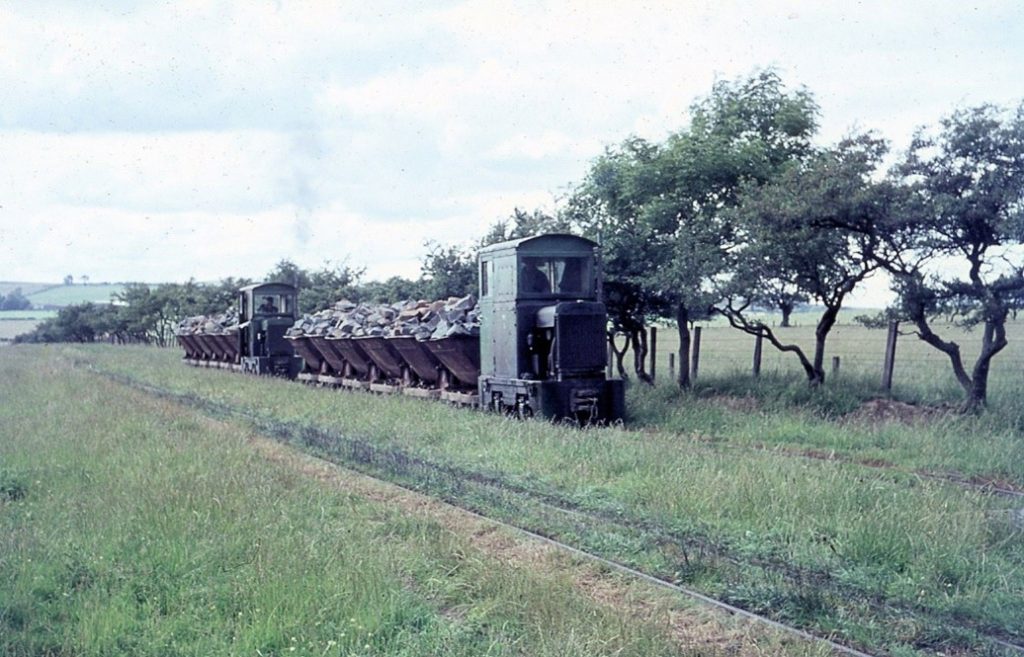In April 1921 the Northumberland County Council Roads and Bridges Committee decided that 16,000 tons of stone were necessary for improvements to the A1 road between Felton and Alnwick. At an annual rent of £10 and a payment of 6d (now 2½p) per ton the Duke of Northumberland agreed that the old quarry at Hare Crag, located to the west of the road, could be reopened. The reopening occurred almost immediately and rails were laid from the quarry to a depot beside the A1, opposite the former brickworks. Much plant was moved to this site including a portable stone crusher, screens, conveyors, a forge, a portable engine, a blacksmith’s shop, a loading gantry, a shed for the locomotives and a weighhouse, plus a ‘tar plant’ with a boiler and tar tank for making macadam.
The distance between the quarry and the roadside depot was about 1.4 miles but the trackwork, including sidings, extended to about two miles. All parts of the quarry had sidings leading to the individual stone faces, some of which were 50’ in height, the stone being brought down by blasting which always took place at the start of the working day. Small tipper wagons were loaded (some might say overloaded) by shovels wielded by small teams of men and formed into trains of about six wagons, each train carrying about fifteen tons of stone. Smaller diesel locomotives were used for shunting wagons at the quarry but larger ones took the stone trains from the quarry to the depot and returned the empties to the quarry. Around 150 tons of stone were moved each day, thus totalling 50,000 tons per year, when the system was working to capacity.

Some of the stone was converted to tarmacadam at the depot whilst the remainder was used as a top dressing on the road. Originally the rail line had several loops to allow full and empty trains to pass each other but by 1948 the loops were removed and modified working was introduced in which two (or more) trains, with suitable intervening gaps) could process along the line together. Before the start of the morning work a ‘paddy train’ would convey the quarrymen from the depot up to the quarry and at the end of the day they would be returned to the depot, from where they could walk to their homes in Shilbottle or Alnwick. The paddy train consisted of three flat wagons fitted with seats and canvas shields providing rudimentary protection from the weather. All of the locomotives were fitted with cabs to protect the drivers from the weather.



The County Council continued to invest in the plant over the years a new weighbridge, new conveyors and various buildings, including an office, were built at the depot site. In 1932 records show that 44 men were employed at the works, with the majority, 29, living in Alnwick. The balance resided at Newton-on-the-Moor, Felton, Shilbottle and Longhorsley. A bothy was provided at Hare Crag for use on weekday nights by some of these workmen who found it difficult to return home each evening and arrive in time for work the following morning.
In the 1960s parts of the quarry were worked out and being filled in with Alnwick’s domestic rubbish. The rails were lifted and in 1966 a roadway was laid for remaining stone to be led from the quarry by road lorries. The locomotives, rolling stock and rails were sent for scrap. In 1969 the NCC finally closed the quarry though it was briefly reopened by Messrs. Alan Davison (Construction) of Houghton-le-Spring who removed some 100,000 tons of stone in the 1970s. The quarry was then filled with some two million tons of domestic waste and other landfill material. The depot site, by the A1, became a Civic Amenity Site where people could leave materials for recycling or for landfill, then later it became the site of a composting plant. The site of the quarry on the hillside is now barely discernible.